
|
May 14
I'm leaving Jerusalem for a few days of travel Up North, to visit Haifa, Akko, Caesarea, and Tel Aviv.
Then it'll be back to Jerusalem for the last several days of my time in Israel.
|
|
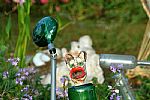
|
Through the kind hospitality of a couch-surfing host...
|
|
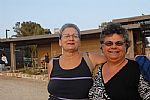
|
...that's her, Varda, on the right, (and her friend on the left) I'll be staying a few nights at Varda's home in Pardes Hanna-Karkur, a town about 30 minutes outside Haifa.
|
|
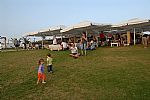
|
Varda, her friend, her son, and I went to family night at a beach club at Caesarea, a town well know for its long history of building and re-building of the harbor.
More coming on Caesarea tomorrow.
|
|
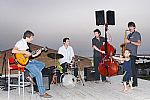
|
They had a swingin' jazz combo...
|
|
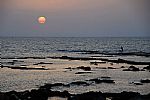
|
...and a Friday night sunset.
|
|

|
May 15
Caesarea! A huge complex of ruins from five or six different cities, each predecessor ruined by the ravages of war and more ruinously by the ravages of earthquakes.
Varda dropped me off here this morning so I could walk around for a couple hours.
It was King Herod, Herod the Great, who, from around 25-13BC, concieved to build a grand artificial harbor here on the site of Pyrgos Stratonos ("Strato" or "Straton's Tower"), and his achievement in doing so was a marvel of its time.
|
|
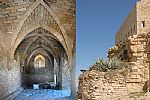
|
After Herod died the Romans took control (sound familiar...from the Masada story). It was a massacre of Jews here in 66AD that led to the Jewish Revolt and the ultimate fate of the revolt at Masada.
As the Roman era came to its end Caesarea became the center of the Byzantines and hence early Christianity, in Palestine.
|
|
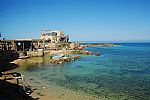
|
In the 7th century the city was conquered by the Muslims and slowly abandoned to agriculture.
"The walls remained, but within them the population dwindled and agriculture crept in among the ruins. When Baldwin I took the city in 1101/2, during the First Crusade, it was still very rich, nevertheless."
|
|
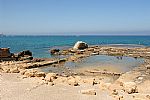
|
"Saladin retook the city in 1187; it was recaptured by the Crusaders in 1191, and finally lost by them in 1265 this time to the Mamluks, who ensured that there would be no more battling over the site, where the harbor has silted in anyway, by razing the fortifications, in line with their practice in other formerly-Crusader coastal cities."
|
|

|
Much of what we see at the site are restorations, and bits have been moved around but that is not surprising considering the long history of building here.
|
|
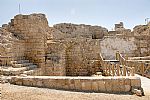
|
More! It is a huge site and I only saw the main structures in the central area. There are many sites to see further afield including a very large section of the marvelous Roman acquaduct.
|
|
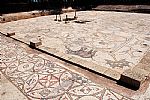
|
Varda picked me up and we were off for an afternoon of art appreciation.
This is a floor that has survived since the end of the 6th century from a Byzantine palace known as the Birds Mosaic Mansion. This would have been the central courtyard.
|
|
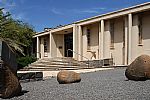
|
Next, the Mashkan Le'Omanut at the Kibbutz Ein Harod, one of Israel's major art institutions.
|
|
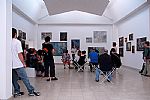
|
They were showing 'A Selection of Israeli Art from the Collection of Gaby and Ami Brown', the show demonstrating the great historical sweep of Israeli art.
There was a two hour lecture in Hebrew that everyone was enjoying and that I read about in the very extensive catalogue of the show.
|
|
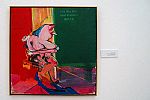
|
My favorite, untitled, 1969, by Michael Druks.
|
|

|
Then on to another Kibbutz and another gallery, this one much smaller, for the opening of an exhibit of Asian style tea cups.
|
|

|
The Party!
|
|
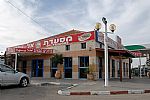
|
We ate a late lunch-early dinner here, at what Varda called 'an Arab place'. It was Saturday afterall, and many establishments were closed.
|
|
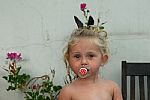
|
A visit with Varda's daughter and son-in-law and grandbaby. Aren't grandbabies just The Thing?!
|
|

|
And back home for a stroll in the garden and a quiet evening to do these pictures.
Tomorrow: Haifa.
|
|
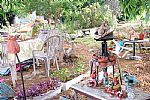
|
May 16
Here we are, a morning in the garden.
|
|
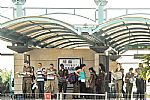
|
And then off to the train for an outing in Haifa.
It's Sunday and the trains were packed with military going back to duty after their weekend off. I mentioned about the universal service right out of high school, meaning that most of these soldiers are basically teenagers.
Teenagers, full of hormones and angst, with automatic weapons that they carry with them around town. They carry them around even when they're off duty. One guy told me 'of course, the gun is their private property'. I'm not sure of that one!
They do seem quite well disciplined though, and I never got the feeling I or anyone else was in danger.
Update from Hilla: 'Once you are issued a weapon from the army you are obliged to keep it with you at all times. Anything that happens by use of that weapon is your responsibility.' So now when I look at these kids I wonder about the ones who Don't have weapons.
|
|
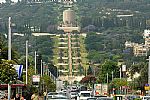
|
I walked through the German Colony, and this is the view to the Baha’i Garden from there.
The German Colony is a street of refurbished buildings from the era when Germans populated the area. It's now a hot club, restaurant, shops, and hotel scene.
Notice the shrouded shape in the upper center. That's the Baha'i Shrine, burial place of the Bab, under refurbishments. From here you can see the Lower Gardens...
|
|

|
...and from here on the other side of the shrine you can see the Upper Gardens.
After walking up that long street to the visitor's center I took a bus up to above the Garden. It's all about the views.
|
|

|
Lacy and appealing.
|
|
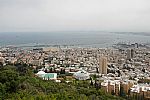
|
Another (and third to last) view. The guide at the Baha'i said you can usually see Akko from here but the haze is in the way today. I walked all the way down from there!
|
|
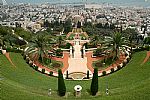
|
All of the Upper Gardens looking down.
The opening paragraph of Ms Wiki's article and you can read the rest any time:
"The Bahá'í Faith is a monotheistic religion founded by Bahá'u'lláh in nineteenth-century Persia, emphasizing the spiritual unity of all humankind. There are an estimated five to six million Bahá'ís around the world in more than 200 countries and territories."
|
|

|
There were several elaborate and classicaly designed buildings on the site.
|
|
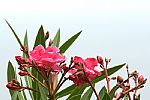
|
So much of the foliage is familiar. Oleander, bougainvillea, geraniums, palm trees, it's all very Southern Cal.
|
|
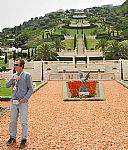
|
The guide and Another view of the gardens.
|
|
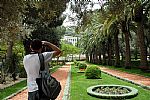
|
I walked on the tour along with this charming young fellow from France. At one point early on we were taking pictures and I asked if he wanted me to take one of him with his camera. No, he said, I have plenty of pictures of myself.
Hey, that's what I always say!
|
|
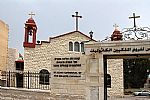
|
Who are the Melites? "The Melkite Catholic Church retains its Byzantine roots and liturgical practices similar to those of the Eastern Orthodoxy while maintaining communion with the Catholic Church in Rome since 1729."
I've seen so many churches in Israel, and there are so many more on the maps that I didn't see. It does seem the churches and mosques are the most prominent buildings on the skyline.
|
|
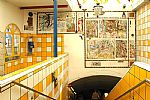
|
Back at the waterfront, the first station of the Carmelit, an underground funicular railway and the only subway in Israel. This is the drama of the entrance...
|
|
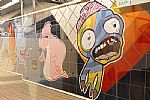
|
...and this is what you get on the walls from inside the cars. Yikes!
|
|
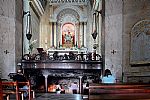
|
The Stella Maris church and monastery, Stella Maris meaning Star of the Sea. This is a charming small church, not very big at all, yet the monastery associated with this church is the world center for the Carmalites.
Usually you light the candles along the side of the church but here you can see they have a cave-looking space, maybe because Elijah's cave is right down the road? But come to think of it I have seen this style in other places too.
|
|
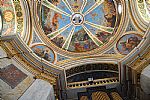
|
The handsomely decorated dome.
|
|

|
Right outside the church is this tramway. Just looking at those babies was enough. I caught a near-by bus to the train to the bus. I put some miles on myself today!
|
|
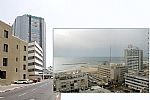
|
May 17
I've moved on to Tel Aviv today and wow I got such a deal. Mostly every single both-reasonable-and-good place was booked up they say because of the upcoming holiday of Shavuot but this place had an itty bitty single with a View of The Sea(!), that's my view there!
For some lucky reason I got a block of days for a price I was willing to pay. It's 25% less than the internet rate even and doesn't good luck just make you feel all perky?
|
|

|
This area of Tel Aviv, here by the beach, is a little run down and I haven't been on the streets at night yet, but it does remind me of some of the pre-refurbishment areas of South Beach, Florida.
So did the weather - Hot and Muggy.
|
|

|
Another view of a side street.
Of course there's a whole big capital city to look at but for today it's just the beach and Jaffa.
|
|
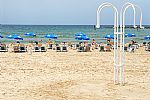
|
And there's several miles of this (walk walk walk!) leading to the historic port town of Jaffa, inhabited first in 7,500BC and pretty much constantly in use since then, but destroyed so many times in whole and in part that not much really old is still around.
|
|
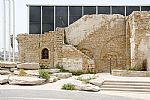
|
This is a cool looking museum, but it was closed, as was the tour of the big church and the tour of the fortifications. Lots of work going on.
|
|

|
Anyone can name all these? Not me!
|
|
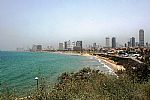
|
A view from Old Jaffa looking onto the modern coastline.
|
|
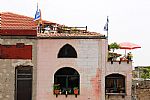
|
There was a sign listing important dates in the history of the Jaffa port - there were 35 entries. The last is as follows: "November 13, 1960 the Old Jaffa Development co was established by Tel-Aviv-Jaffa Municipality and the Government of Israel in order to bring an end to the "Shetach Hagadol" which had been, until then, a breeding ground for prostitution, drugs, and crime and to convert it into a tourists' area consisting of an artists' quarter and recreational facilities. In addition, the Company is responsible for all municipal services."
So they got rid of the breeding-ground and tidied up for the tourists.
|
|
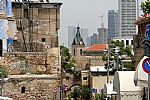
|
The clock tower.
"The Clock-Tower in the center of Jaffa was built in 1906 to mark the 50-year jubilee of Sultan Abdul Hamid II. On the tower is a plaque commemorating the Israelis killed in the battle for the town in 1948."
|
|

|
An example of tiding up on the steep and curving streets.
|
|
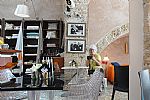
|
I had a bowl of fruit and yogurt here and it was pretty good too.
Then I went back (walk walk walk!) to do some housekeeping like all my laundry was waaay full of stinky sweat.
I'm not sure what I'm going to do tomorrow. Now I'm thinking instead of trying to rush through Akko (last train leaves at 2:25 because of the holiday) I'll wait until Thursday and overnight. Just a thought.
|
|
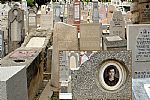
|
May 18
One block from my hotel is The Old Cemetery "with a common grave containing the remains of victims of the 1921 troubles and the tombs of leading Zionists like Chaim Arlosoroff, Meir Dizengoff (first mayor of Tel-Aviv) and Max Nordau and the poets Chaim Nahman Bialik and Shaul Tchernikowsky."
It was extra intense, the way all the graves are side to side, head to toe with each other and then all with these elaborate headstones.
|
|

|
One of the myriad entrances to the Carmel Market that runs along the edge of the Yemenite Quarter. You know I'm not going in there!
|
|
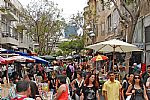
|
Nearby is another market street, Nahalat Binyamin Market that I think is in action only Tuesdays and Fridays. It's also streets and streets, these of handmade crafts.
I could walk through here as the claustrophobia factor was quite low, comparatively speaking. It was 95% crafty decorative and gift items, and of pretty high quality too I thought.
|
|
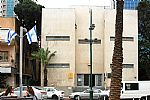
|
There were a couple small museums I was interested to see. One was about the Haganah, predecesor to the IDF, but they were closed.
This is the outside of Independence Hall "the former home of Meir Dizengoff, Tel Aviv’s first mayor, (and) is also where Israel’s independence was proclaimed."
|
|

|
Of course it was very nationalistic in there, as you'd have to expect I think.
|
|
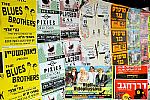
|
Posters around town. Don't miss the Vopli Vidopliassova, the Ukranian Rock Band.
|
|

|
Here's something interesting first about Tel Aviv and also about the UNESCO World Heritage designation for a neighborhood called The White City:
"Tel Aviv was founded in 1909 and developed as a metropolitan city under the British Mandate in Palestine. The White City was constructed from the early 1930s until the 1950s, based on the urban plan by Sir Patrick Geddes, reflecting modern organic planning principles.
"The buildings were designed by architects who were trained in Europe where they practiced their profession before immigrating. They created an outstanding architectural ensemble of the Modern Movement in a new cultural context."
|
|
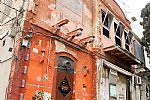
|
This tells us Tel Aviv is relatively new (Jaffa (at the time an Arab city) being the ancient place) and there is a The White City which, when I asked the guy at the hotel 'where is The White City?' he drew a huge circle on the map and said 'around here'.
So I went around there and it was quite marvelous.
Take this building which is clearly in desperate need of refurbisment but is still in use as a night club.
|
|
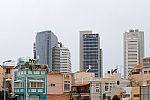
|
In fact there were blocks and blocks of very cool buildings...
|
|
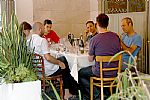
|
...and streets full of every type of entertainment - shops of every trendy description, eating-drinking-dancing, and several ice cream places on every block.
These guys are having a wine tasting with the fellow in purple leading the discussion. Maybe he was a salesman or maybe it was a staff orientation, either way it was a serious proposition.
|
|
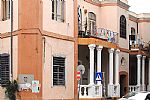
|
This used to be an art space, or so the woman in the shop next door told me.
|
|
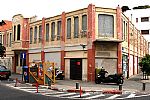
|
Check out those lamps.
|
|

|
What the local street scene looks like on a family day out.
|
|
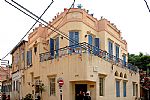
|
I don't know what I used to think of Tel Aviv but I never would have thought of a building like this one.
|
|
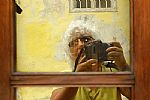
|
What works best for me for long days walking - 3 hours walking, 1 hour snack stop, 2 hours walking for a 6 hour day...longer only with more snack stops!
It just doesn't always work out that way. Like today... late start, more than 4 hours walking without a break, back at the hotel for a rest, and a late night snack from the Equadorian chicken place down the street.
|
|
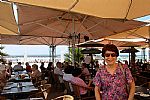
|
May 19
I had a lovely afternoon here at the beach today with Hilla, mother of Jonathan's wife Judy.
|
|
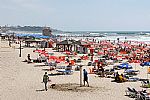
|
It was particularly busy because of the holiday.
|
|

|
We went up to my room to look at one of Hilla's projects on the computer and she said 'oh, it's the American Embassy.'
I've looked out this window 100 times in the last two days and never noticed! Right under the medallion it says Embassy of the United States of America. And then the flag should have given it away.
|
|
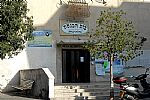
|
I mentioned before how the skylines seemed dominated by church steeples and mosque minarets. I never even notice the synagogues and now I know why. This is a synagogue that Hilla pointed out. There is no big obvious universal symbol or shape, nothing sticks up, and no English which is why I've probably passed who knows how many and not known.
|
|
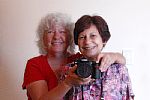
|
A not-enough-light shot of us as cute as we need to be!
|
|
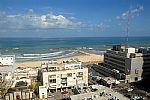
|
May 20
I left Tel Aviv this morning to take the train to Akko. It was fun in Tel Aviv, and interesting. I'm glad to have visited.
Just one small thing. The flies. I felt like a horse, stomping and shaking my leg and if I had a tail that would have been good too. Also there was a lot of smoking. Between the smoke and the flies it was not so easy to just sit outside. (An exception - lunch with Hilla was outside without smoke and without flies. I was SO happy!)
|
|
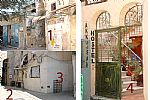
|
Arriving in Akko I walked from the train just in some general direction to get to the Old City. My plan was that once there I would 1) find a visitor's center, 2) get a map, and 3) find my hostel.
1) and 2) worked out fine but the woman at the visitor's center said 'very confusing'. She said she would call the hostel and someone would come to walk with me. Good thing I guess!
|
|
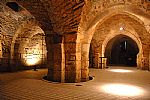
|
Akko's history is much along the lines of all the others in this part of the world, although here a lot more of various original buildings survived.
Here we go: The Helenic period; Romans; Byzantines; Arabs; Crusaders; Arabs; Ottomans; British mandate; Jewish state.
The most complete buildings, continually being revealed and restored is the Crusader era fortress.
|
|
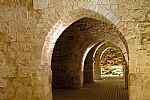
|
btw, The English name for Akko is Acre.
"In the 1947 UN Partition Plan, Acre was designated part of a future Arab state. During the war of 1948, Acre was besieged by Israeli forces. ... Acre was captured by Israel on May 17, 1948 and about three-quarters of its Arab population (estimated at 13,000 in 1944) became displaced as a result."
|
|

|
Notice above the blue door 'Peace Shop'. The guy running the sandwich place where I ate lunch was telling me how Akko was unique in all of Israel in that here the Arabs and Jews could/would/were living in the actual same city.
|
|
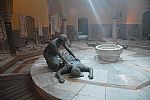
|
Another tourist stop - an Ottoman era hammam...
|
|
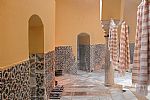
|
...with a programmed tour, kind of like a Disneyland thing where the speakers kick in as you move through the rooms. Not speakers, but your headset that is programmed for whatever language you specify.
It reminded me again how dirty one gets when 'on the road' and how glorious a nice scrub-down would be.
|
|
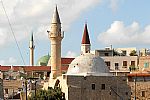
|
Two mosques and one church.
|
|

|
There's this one giant bay, picture the letter C, with Haifa on one tip and Akko on the other. Today Haifa was barely visible from Akko.
|
|
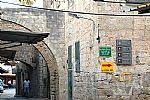
|
They are serious about their tourism here in the Old City of Akko. Once you get there, you are quite sure to get to the major sites since soon enough you will run into these signs.
There's a new city too that I walked through when coming from the train. No tourists go there except the Baha'i pilgrims as their holy sites are not inside the Old City walls.
|
|
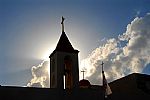
|
These kinds of pictures always remind me of being in high school yet here I am, a Senior Citizen, still taking them.
|
|
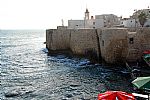
|
The sea walls, I don't know from what date but these guys don't last for long I imagine.
|
|
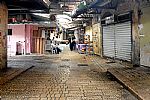
|
Walking back through the market streets after everything is put away. Three hours earlier it would have been nearly impossible to pass. (No big fly problem in Akko, not even in the stickiest, ickiest part of the market.)
It's hard to see, the guy in the white chair has got out his hookah. As I passed through the streets around 7pm it seemed everyone was settling into their 'spot' ready to put down the cigs and enjoy an evening hookah.
|
|
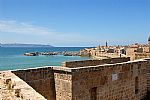
|
May 21
I had a last few hours in Akko before moving on to Jerusalem for my last four nights in Israel.
This is a view of the sea walls and the little port from yesterday with Haifa in the distance.
|
|
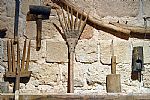
|
As part of the combo-ticket to a package of sites was a museum built into the fortress walls. Here we have hand tools, hand made.
|
|

|
This place met my street-food criteria - if there's a line of people clammoring for food, get in that line. There was a line and the line didn't stop the whole time I was there.
It's a falafel shop and that guy who is pointing, he's a regular falafel makin' maniac. It was indeed a very tasty falafel.
|
|

|
Farewell Akko, it's been lovely!
Tomorrow I've got a few evening photos for the Jerusalem secton to which we will be returning, adding on as it were.
|
|